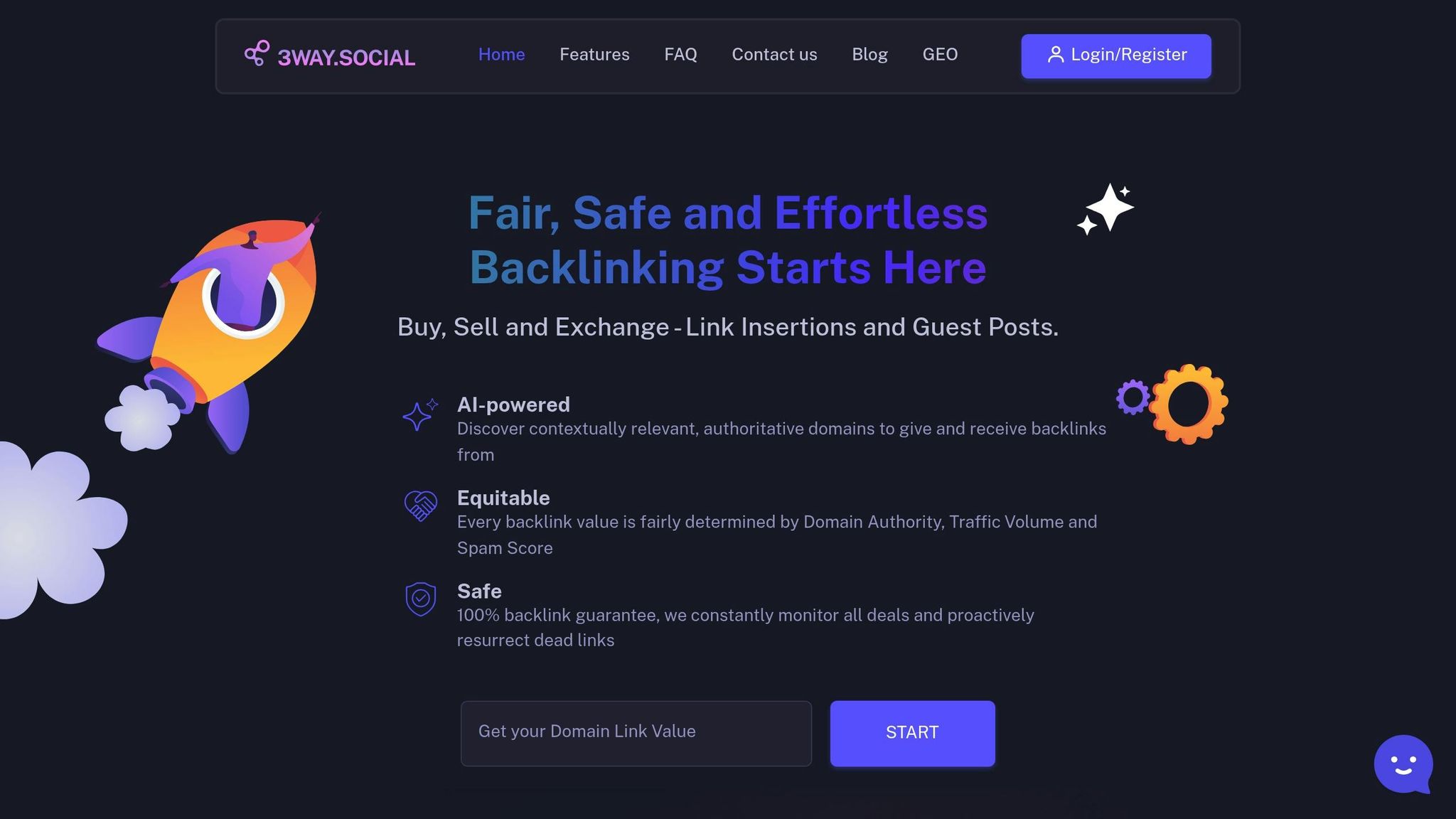Last Updated on September 8, 2025 by Becky Halls
Tracking competitor link velocity means analyzing how quickly your competitors gain backlinks over time. This helps you understand their SEO strategies, spot trends, and set realistic goals for your own growth. Here’s how you can do it:
- Why It Matters: Link velocity shows whether competitors are using steady, ethical growth or risky, short-term tactics. It also reveals seasonal trends like pre-event link-building spikes.
- Choosing Competitors: Focus on direct rivals with similar domain authority, shared keywords, or local relevance. Include aspirational competitors to learn from industry leaders.
- Best Tools: Use platforms like Ahrefs, SEMrush, Moz, Majestic, or Google Search Console for tracking. Tools like 3Way.Social provide advanced insights into link quality and diversification.
- Step-by-Step Process: Build a spreadsheet to track backlinks, analyze data weekly or monthly, and visualize trends using charts. Watch for spikes or drops in link-building activity.
- Actionable Insights: Identify patterns like natural growth or campaign-driven spikes. Use this to set achievable goals and refine your own backlink strategy.
Tracking link velocity helps you stay competitive by understanding your rivals’ strategies while improving your own. Start monitoring today to build a stronger, more consistent backlink profile.
How To Do A Competitor Backlink Analysis Using Free & Paid Tools (A Step By Step Guide)
How to Choose Competitors to Track
Choosing the right competitors to monitor can give you a clearer picture of what works in your industry. The trick is to focus on businesses that target the same audience and keywords, while operating at a comparable or higher level than your own.
Pick the Right Competitors
Start by identifying direct competitors that rank for your primary keywords. Pay attention to competitors with a domain authority within 10–20 points of your own – this range is ideal for finding relevant link-building opportunities.
Look for competitors consistently ranking in the top 10 for your target keywords. These sites have already established themselves as credible authorities in your niche. Also, prioritize websites that have recently climbed the rankings, as their strategies are clearly working.
A major factor to consider is keyword overlap. Competitors who share at least 30% of your target keywords often follow similar content strategies and attract backlinks from comparable sources. This makes them valuable to study.
For local businesses, geographic relevance is critical. For instance, a plumbing company in Chicago should focus on other Chicago-area plumbers rather than national chains. Local competitors are often vying for the same citation sources and community relationships, making them more relevant for analysis.
Lastly, don’t ignore aspirational competitors – those you’d like to compete with in the future. These might be websites with higher domain authority or a broader reach. Tracking their link-building velocity can give you insights into what growth looks like at the next level.
Once you’ve identified the right competitors, organize your findings for easy tracking and analysis.
Build Your Competitor List
To keep things manageable, create a spreadsheet with key details for each competitor. Include columns for:
- Competitor name
- URL
- Domain authority
- Primary keywords
- Monthly traffic
This setup helps you track multiple competitors side-by-side and spot trends over time. Keep your list focused by limiting it to 5–10 competitors. Too many can overwhelm you and make it harder to identify meaningful patterns.
Structure your list into tiers for better clarity:
- Direct competitors: 2–3 businesses at your current level.
- Slightly ahead competitors: 2–3 businesses performing better than you.
- Industry leaders: 1–2 aspirational competitors that set the bar.
Make sure to validate each competitor by checking their recent backlink activity. A competitor that hasn’t gained new links in six months won’t provide useful insights into ongoing strategies, even if their authority is high.
Finally, update your list quarterly. The competitive landscape changes frequently – new players emerge, strategies shift, and some competitors may become less relevant as your site grows and evolves. Regular updates ensure your analysis stays fresh and actionable.
Best Tools for Link Velocity Tracking
Tracking backlinks manually can be a time-consuming task. Thankfully, specialized SEO tools make this process much easier by automating data collection and offering insights that help identify link-building patterns and opportunities.
Popular SEO Tools Overview
Ahrefs is well-known for its extensive backlink database. It provides historical tracking, allowing you to spot spikes or drops in link acquisition. You can monitor new backlinks and linking domains over time, making it an excellent tool for keeping tabs on your link-building progress.
SEMrush simplifies backlink tracking with automated alerts for newly gained or lost links. It also offers in-depth competitor analysis, saving you the hassle of manually checking competitor profiles.
Moz Link Explorer focuses on evaluating the quality of backlinks. It flags potential risks by assessing link authority and identifying spam signals. This helps you determine whether competitors are building sustainable link profiles or taking shortcuts that could backfire.
Majestic stands out for its ability to analyze link type distribution. It provides a breakdown of follow vs. nofollow links and text vs. image links, ensuring that link profiles appear natural rather than manipulative.
Google Search Console is a reliable, free tool that provides accurate data for your backlinks. It serves as a solid baseline for comparing your link profile to competitor data tracked with other tools.
When deciding which platform suits your needs, consider whether you require in-depth backlink analysis or a broader range of features like keyword research. Agencies managing multiple clients might benefit from tools offering white-label reporting and multi-client dashboards. Most platforms offer free trials, so you can test their features and integration options before committing. Additionally, newer platforms like 3Way.Social provide a fresh perspective on link velocity and growth strategies.
Using 3Way.Social for Link Growth Analysis

While traditional SEO tools excel at tracking backlinks, 3Way.Social takes it a step further by focusing on quality link exchanges. Its AI-powered domain matching feature identifies opportunities for high-quality exchanges that align with your competitors’ strategies.
The platform’s analytics dashboard tracks link velocity trends, offering insights into the performance of your link exchanges and guest posting efforts. This data is especially useful when trying to match or outpace your competitors’ link acquisition rates.
Another standout feature is its focus on link diversification. By analyzing the types of domains and contexts that work best in your industry, 3Way.Social helps you build a natural and strategic approach to increasing your link velocity.
Instead of simply counting backlinks, 3Way.Social emphasizes quality and relevance. It ensures that your efforts to improve link velocity are grounded in meaningful connections, not just raw numbers.
The platform also includes a secure SEO network where you can benchmark against similar websites in your niche. This peer-to-peer insight complements the competitive intelligence gathered from traditional tools, giving you actionable strategies to refine your link-building approach. By combining these insights with data from tools like Ahrefs or SEMrush, you can create a well-rounded strategy for sustainable link growth.
sbb-itb-88880ed
Step-by-Step Tracking Process
Once you’ve selected your tools and identified competitors, it’s time to dive into tracking link velocity. A clear, step-by-step process ensures you gather accurate data and keep it well-organized for meaningful analysis.
How to Collect Link Data
Start by creating a spreadsheet to track key details: competitor names, dates, total backlinks, new links, and linking domains. This will serve as your central hub for data collection.
Next, enter each competitor’s URL into your SEO tool of choice (e.g., Ahrefs’ Site Explorer). From there, navigate to ‘Backlinks’ → ‘New’ and set date ranges such as 1, 3, 6, and 12 months. This helps capture link-building trends over time. If you’re using SEMrush, go to Backlink Analytics, select the competitor, and choose ‘New & Lost Backlinks’.
Export the data in US format (MM/DD/YYYY) and ensure numbers use commas as thousand separators (e.g., 1,250). For consistency, set up automated tracking by scheduling weekly or bi-weekly data collection. Document your schedule and methodology in the spreadsheet – this will help you spot sudden changes, like a competitor jumping from 15-20 new backlinks per week to 80 in a single week.
While collecting data, keep an eye on important metrics like Domain Rating (DR)/Domain Authority (DA), anchor text distribution, and link types (dofollow vs. nofollow). Note any filters or anomalies you encounter in the spreadsheet to make future trend analysis easier.
Once your data is organized, you’re ready to visualize and compare results.
Create Charts and Compare Results
Turn your raw data into visual summaries to uncover patterns more easily. For instance, use a line chart with time on the X-axis and new backlinks per month on the Y-axis. Assign each competitor a separate line to track their link acquisition trends over time.
Another useful tool is a velocity comparison table. Include columns showing the average monthly link gains for each competitor over 30-day, 90-day, and 180-day periods. This makes it easier to pinpoint which competitors show steady growth versus those with occasional bursts.
Be on the lookout for seasonal trends in your data. For example, link-building activity often slows in December and January but picks up in February and March. E-commerce competitors may see spikes in link velocity before major shopping seasons. Spotting these patterns can help you plan your own campaigns more effectively.
Highlight anomalies in your charts. For example, if a competitor gains 200 backlinks in a week, it may signal a successful PR campaign, a guest posting spree, or even a questionable link scheme. Drill down into the links acquired during these periods to uncover the cause.
To get a deeper understanding, create separate charts for different link types. For instance, compare homepage links versus deep links, or editorial links versus directory submissions. This breakdown can reveal whether competitors are focusing on building authority for their main pages or driving traffic to specific content.
Use conditional formatting in your spreadsheet to flag key changes. For example, set cells to turn red when link velocity drops below historical averages or green when it exceeds typical performance. This visual cue makes it easy to spot trends at a glance.
Lastly, consider calculating rolling averages to smooth out short-term fluctuations and focus on long-term trends. A 4-week rolling average, for example, can help you see whether a competitor’s link-building efforts are gaining momentum or losing steam over time. This approach keeps you focused on the bigger picture rather than week-to-week noise.
How to Read and Use the Data
Now that your data is organized, it’s time to dig in and analyze it. This step helps uncover your competitors’ strategies, budgets, and overall approach. Combine these insights with your visual charts to get a clearer picture of their tactics.
Spot Different Link Building Patterns
Link velocity data can reveal distinct link-building strategies. Here are some common patterns to look for:
- Natural growth: A steady increase with minor fluctuations. This often points to organic efforts like content creation and relationship-building.
- Aggressive link building: Sudden, dramatic spikes in backlinks. These could indicate paid strategies, large-scale outreach, or specialized link-building services. Such spikes often happen in short, intense bursts followed by quieter periods.
- Campaign-driven patterns: Predictable surges tied to events like product launches, seasonal promotions, or PR campaigns. Competitors may maintain a steady baseline of link acquisition with temporary increases during these high-visibility moments.
- Stagnant competitors: Little to no growth over time, which might suggest outdated strategies or a lack of focus on SEO.
While analyzing these patterns, also evaluate link quality. For example, abrupt spikes followed by sharp declines could signal risky tactics like link schemes or expired domain redirects – practices that search engines often penalize.
Set Realistic Link Building Goals
Once you’ve identified patterns, use them to set achievable link-building goals. Your competitive insights and charts can serve as benchmarks to guide your strategy.
- Align goals with your domain authority and budget: If your site has lower authority, aim for steady, incremental growth. Established sites can afford to pursue more ambitious strategies.
- Focus on quality over quantity: A smaller number of high-quality backlinks is far more valuable than a large volume of low-quality ones.
- Consider industry-specific trends: Some industries naturally attract fewer but higher-quality backlinks, while others may see a higher volume due to shareable content. Understanding your industry’s typical patterns is key.
- Account for seasonality: Many industries experience slower link growth during holidays or specific times of the year. Adjust your targets accordingly.
- Scale with growth: Start by setting goals relative to your competitors, then gradually increase your targets as your domain authority and content library expand.
For long-term success, prioritize securing backlinks from reputable sources. Monitoring your link-to-content ratio can help you evaluate the effectiveness of your efforts.
If you’re using tools like 3Way.Social for strategic link exchanges, take advantage of the vetted partnerships they offer. These platforms can complement your natural link growth while maintaining high editorial standards.
Finally, regularly measure your progress against competitor benchmarks. However, avoid overreacting to short-term fluctuations. Sustainable link building takes time and consistent effort, but it pays off with steady improvements in both link velocity and search rankings.
Conclusion
Competitor link velocity gives you a clear picture of how quickly your rivals are building backlinks and gaining SEO traction. By tracking this pace, you can better understand their progress and adjust your own link-building strategies accordingly.
This data helps you set realistic goals and avoid potential missteps. For example, if you notice a sharp spike in a competitor’s backlinks, it’s worth investigating. Is it the result of an effective campaign, or could it involve risky tactics that might lead to penalties? These insights allow you to fine-tune your own approach and stay proactive.
Using tools like Ahrefs and Majestic ensures you stay informed about changes in the search landscape. Regular monitoring helps you catch trends early, giving you the chance to adapt your strategy before competitors gain too much ground.
For a smarter, more sustainable approach, platforms like 3Way.Social can be a game-changer. Their ethical, AI-powered link exchange system connects you with a network of vetted SEO professionals, making it easier to build high-quality backlinks at a steady, natural rate – minimizing risks while supporting long-term growth.
As mentioned earlier, consistent tracking and thoughtful adjustments are key. Whether you review your data monthly or quarterly, these check-ins help you benchmark progress, spot emerging trends, and refine your strategy. Keep in mind, link building is a marathon, not a sprint. Monitoring link velocity gives you the insights needed to make steady, meaningful improvements in your backlink profile and search rankings.
Start analyzing competitor link velocity today and stay one step ahead in your SEO game.
FAQs
How can I tell if a competitor’s link velocity strategy is ethical or potentially harmful?
To assess the ethics and potential risks of a competitor’s link velocity strategy, start by observing how their backlinks grow over time. Ethical approaches usually feature a gradual and consistent increase, mirroring natural, organic growth that aligns with Google’s guidelines. On the other hand, sharp spikes or erratic growth patterns might point to questionable or manipulative tactics.
Another key factor is the quality and relevance of their backlinks. A large number of low-quality or unrelated links can be a red flag for black-hat strategies, which could result in penalties. By keeping an eye on the consistency of their backlink profile and ensuring the links seem organic, you can better judge whether their strategy aligns with ethical practices or carries potential risks.
What makes tracking link velocity with 3Way.Social better than using traditional SEO tools?
Tracking link velocity with 3Way.Social comes with several perks that set it apart from traditional SEO tools. By leveraging AI, the platform ensures secure and fair link exchanges, helping you build high-quality, relevant backlinks that promote natural growth. This approach minimizes the chances of penalties caused by unnatural link-building patterns.
On top of that, 3Way.Social provides detailed tracking of how quickly links are acquired, enabling you to make smart, data-backed adjustments to your SEO strategy. Features like domain matching and advanced link diversification make it easier to improve rankings, grow traffic, and strengthen your domain authority – all through a process that’s simple to manage and scale.
How often should I review my competitor list and link velocity data for accurate insights?
To keep your insights sharp and useful, make it a habit to revisit your competitor list and refresh their link velocity data every 3 to 6 months. This regular check-in helps you identify trends, monitor shifts in their backlink strategies, and fine-tune your own SEO approach.
In industries where competition is fierce or rankings seem to fluctuate quickly, you might want to review this data more often to stay on top of the game.



